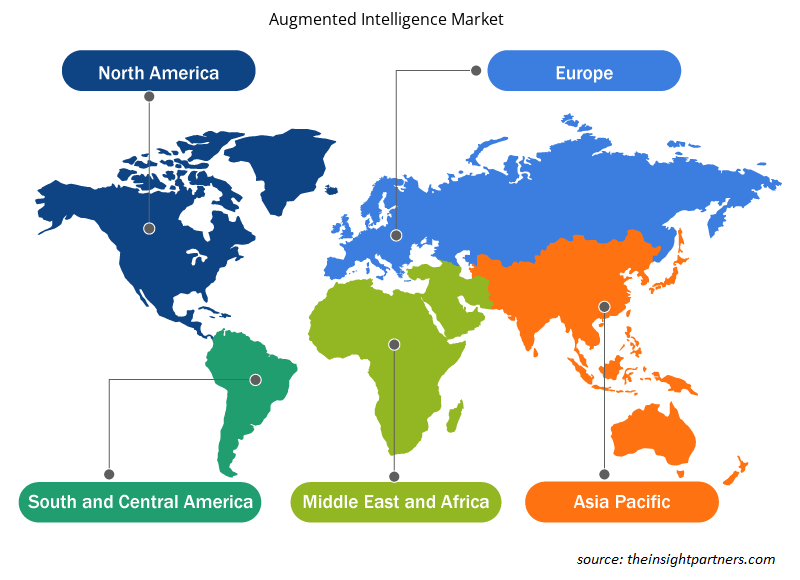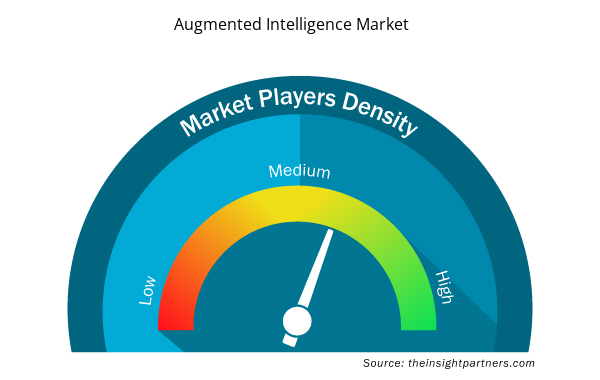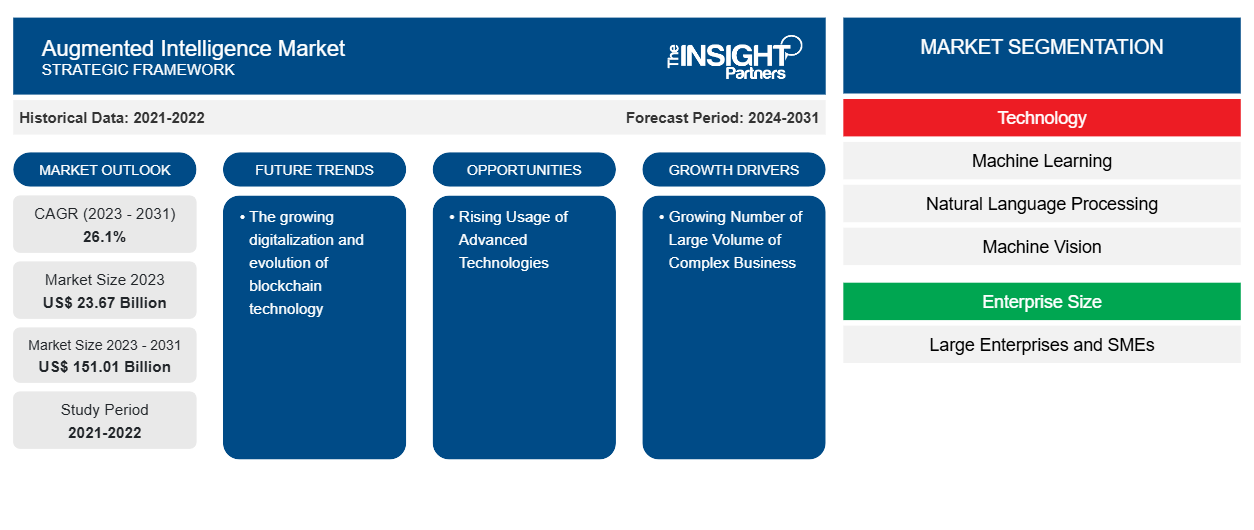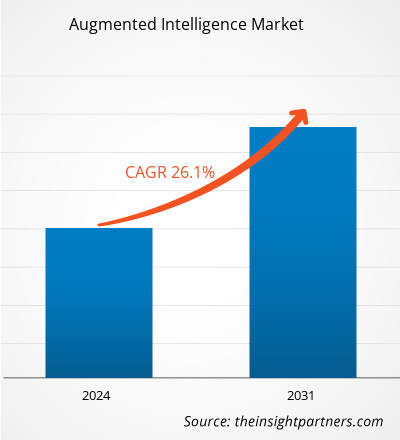Der Markt für Augmented Intelligence soll von 23,67 Milliarden US-Dollar im Jahr 2023 auf 151,01 Milliarden US-Dollar im Jahr 2031 anwachsen. Der Markt soll zwischen 2023 und 2031 eine durchschnittliche jährliche Wachstumsrate (CAGR) von 26,1 % verzeichnen. Die zunehmende Digitalisierung und Weiterentwicklung der Blockchain-Technologie dürfte ein wichtiger Trend auf dem Markt für Augmented Intelligence bleiben.
Augmented Intelligence Marktanalyse
Der Markt für Augmented Intelligence wächst aufgrund der wachsenden Anzahl großer Mengen komplexer Geschäftsdaten und der expandierenden Branchen BFSI, IT & Telekommunikation sowie Einzelhandel und E-Commerce rasant. Der Markt wächst stetig, angetrieben durch die zunehmende Einführung von Augmented Intelligence bei KMU. Darüber hinaus bieten die zunehmende Nutzung fortschrittlicher Technologien und die zunehmende Einführung cloudbasierter Lösungen bei Unternehmen lukrative Möglichkeiten für Marktwachstum.
Augmented Intelligence Marktübersicht
Augmented Intelligence ist eine Art künstlicher Intelligenz, die sich auf die unterstützenden Fähigkeiten der KI konzentriert. Darüber hinaus wird Augmented Intelligence entwickelt, um Organisationen dabei zu unterstützen, im Geschäftsleben und im täglichen Leben genauere, datengesteuerte Entscheidungen zu treffen. Darüber hinaus wird Augmented Intelligence von Unternehmen eingesetzt, um die Leistung ihrer Mitarbeiter zu verbessern, und hilft der Organisation dabei, die Verbesserungsbereiche der Mitarbeiter zu verstehen, was den Markt antreibt. Darüber hinaus ist Augmented Intelligence die effektivste Technik, um eine große Sammlung von Sicherheitsdaten zu nutzen und zu priorisieren, indem sie Unternehmen prädiktive Analysen zur Verfügung stellt.
Passen Sie diesen Bericht Ihren Anforderungen an
Sie erhalten kostenlos individuelle Anpassungen an jedem Bericht, einschließlich Teilen dieses Berichts oder einer Analyse auf Länderebene, eines Excel-Datenpakets sowie tolle Angebote und Rabatte für Start-ups und Universitäten.
- Holen Sie sich die wichtigsten Markttrends aus diesem Bericht.Dieses KOSTENLOSE Beispiel umfasst eine Datenanalyse von Markttrends bis hin zu Schätzungen und Prognosen.
Treiber und Chancen des Augmented Intelligence-Marktes
Die wachsende Zahl großer Mengen komplexer Geschäftsdaten treibt den Markt an
Technologien der erweiterten Intelligenz wie maschinelles Lernen und Verarbeitung natürlicher Sprache werden für die Datenanalyse immer wichtiger. Erweiterte Intelligenz ermöglicht die Analyse organisierter, halbstrukturierter und unstrukturierter Datenquellen, die in Unternehmen gespeichert sind. Die Vielfalt und das hohe Volumen der erstellten Daten werden in den kommenden Jahren voraussichtlich aufgrund der expandierenden Branchen und der Entwicklung digitaler Technologien in allen Unternehmensabläufen erheblich zunehmen. Dies erhöht die Nachfrage der Unternehmen nach Lösungen für erweiterte Intelligenz, um ihre großen Datenmengen effektiv und effizient zu verwalten. Es wird jedoch erwartet, dass das wachsende Volumen komplexer Daten den Markt für erweiterte Intelligenz im erwarteten Zeitraum ankurbeln wird.
Steigende Nutzung fortschrittlicher Technologien – eine Chance auf dem Markt für erweiterte Intelligenz
Die zunehmende Nutzung fortschrittlicher Technologien wie künstliche Intelligenz, maschinelles Lernen und natürliche Sprachverarbeitung schafft im Prognosezeitraum Chancen für Marktwachstum. Viele Branchen wie IT und Telekommunikation, Einzelhandel und E-Commerce, BFSI, Gesundheitswesen und andere generieren riesige Datenmengen und benötigen fortschrittliche Technologien zur Analyse dieser Daten in Echtzeit, was die Nachfrage nach Augmented-Intelligence-Lösungen erhöht. Branchen übernehmen neue Technologien wie künstliche Intelligenz, maschinelles Lernen und natürliche Sprachverarbeitung, um riesige Datenmengen zu analysieren und in Echtzeit effektive Entscheidungen zu treffen. Diese Tools haben den Prozess der Gewinnung von Erkenntnissen aus Daten vereinfacht, was ihre Akzeptanz erhöht und Chancen auf dem Markt schafft.BFSI, healthcare, and others, are generating vast volumes of data and require advanced technologies for analyzing this data in real-time, which increases the demand for augmented intelligence solutions. Industries are adopting new technologies such as artificial intelligence, machine learning, and natural language processing for analyzing vast data by making effective decisions in real time. These tools have simplified the process of extracting insights from data, which increases its adoption and creates opportunities in the market.
Segmentierungsanalyse des Augmented Intelligence-Marktberichts
Wichtige Segmente, die zur Ableitung der Augmented Intelligence-Marktanalyse beigetragen haben, sind Technologie, Unternehmensgröße und Endbenutzer
- Basierend auf der Technologie ist der Markt für erweiterte Intelligenz in maschinelles Lernen, Verarbeitung natürlicher Sprache, maschinelles Sehen, kontextsensitives Computing und andere unterteilt. Das Segment des maschinellen Lernens hatte im Jahr 2023 einen größeren Marktanteil.
- In Bezug auf die Unternehmensgröße ist der Markt in Großunternehmen und KMU segmentiert. Das KMU-Segment hatte im Jahr 2023 einen größeren Marktanteil.
- In Bezug auf den Endbenutzer wird der Markt in IT und Telekommunikation, Einzelhandel und E-Commerce, BFSI, Gesundheitswesen und andere unterteilt. Das BFSI-Segment hatte im Jahr 2023 einen größeren Marktanteil.
Augmented Intelligence Marktanteilsanalyse nach Geografie
Der geografische Umfang des Marktberichts für erweiterte Intelligenz ist hauptsächlich in fünf Regionen unterteilt: Nordamerika, Asien-Pazifik, Europa, Naher Osten und Afrika sowie Südamerika/Süd- und Mittelamerika.
In Bezug auf den Umsatz hatte Nordamerika den größten Marktanteil im Bereich Augmented Intelligence, was auf den technologischen Fortschritt und die Präsenz wichtiger Akteure wie IBM Corporation, Microsoft Corporation, TIBCO Software Inc., Salesforce.com, Inc. und MicroStrategy Incorporated zurückzuführen ist. Diese Akteure investieren erheblich in die Einführung fortschrittlicher Technologien wie KI, ML und NLP und entwickeln diese Technologien kontinuierlich weiter, indem sie zusätzliche Funktionen hinzufügen. Die steigende Nachfrage nach Cloud-basierter Augmented Intelligence in Branchen wie IT und Telekommunikation , BFSI, Einzelhandel und E-Commerce, Gesundheitswesen und anderen dürfte den Markt in Nordamerika ankurbeln.
Regionale Einblicke in den Augmented Intelligence-Markt
Die regionalen Trends und Faktoren, die den Markt für erweiterte Intelligenz im Prognosezeitraum beeinflussen, wurden von den Analysten von Insight Partners ausführlich erläutert. In diesem Abschnitt werden auch die Marktsegmente und die Geografie für erweiterte Intelligenz in Nordamerika, Europa, im asiatisch-pazifischen Raum, im Nahen Osten und Afrika sowie in Süd- und Mittelamerika erörtert.

- Holen Sie sich die regionalspezifischen Daten für den Augmented Intelligence-Markt
Umfang des Marktberichts zur erweiterten Intelligenz
| Berichtsattribut | Details |
|---|---|
| Marktgröße im Jahr 2023 | 23,67 Milliarden US-Dollar |
| Marktgröße bis 2031 | 151,01 Milliarden US-Dollar |
| Globale CAGR (2023 - 2031) | 26,1 % |
| Historische Daten | 2021-2022 |
| Prognosezeitraum | 2024–2031 |
| Abgedeckte Segmente | Nach Technologie
|
| Abgedeckte Regionen und Länder | Nordamerika
|
| Marktführer und wichtige Unternehmensprofile |
|
Dichte der Marktteilnehmer für Augmented Intelligence: Die Auswirkungen auf die Geschäftsdynamik verstehen
Der Markt für Augmented Intelligence wächst rasant, angetrieben durch die steigende Nachfrage der Endnutzer aufgrund von Faktoren wie sich entwickelnden Verbraucherpräferenzen, technologischen Fortschritten und einem größeren Bewusstsein für die Vorteile des Produkts. Mit steigender Nachfrage erweitern Unternehmen ihr Angebot, entwickeln Innovationen, um die Bedürfnisse der Verbraucher zu erfüllen, und nutzen neue Trends, was das Marktwachstum weiter ankurbelt.
Die Marktteilnehmerdichte bezieht sich auf die Verteilung der Firmen oder Unternehmen, die in einem bestimmten Markt oder einer bestimmten Branche tätig sind. Sie gibt an, wie viele Wettbewerber (Marktteilnehmer) in einem bestimmten Marktraum im Verhältnis zu seiner Größe oder seinem gesamten Marktwert präsent sind.
Die wichtigsten auf dem Markt für erweiterte Intelligenz tätigen Unternehmen sind:
- IBM Corporation
- Microsoft Corporation
- SAP SE
- TIBCO Software Inc.
- Sisense Inc.
- Salesforce.com, Inc.
Haftungsausschluss : Die oben aufgeführten Unternehmen sind nicht in einer bestimmten Reihenfolge aufgeführt.

- Erhalten Sie einen Überblick über die wichtigsten Akteure auf dem Markt für erweiterte Intelligenz
Augmented Intelligence-Marktnachrichten und aktuelle Entwicklungen
Der Markt für erweiterte Intelligenz wird durch die Erhebung qualitativer und quantitativer Daten nach Primär- und Sekundärforschung bewertet, die wichtige Unternehmensveröffentlichungen, Verbandsdaten und Datenbanken umfasst. Im Folgenden finden Sie eine Liste der Entwicklungen auf dem Markt für erweiterte Intelligenz und Strategien:
- Im September 2023 stellte Oracle Corp heute neue KI-gestützte Funktionen in der Oracle Analytics Cloud vor. Die neuen Self-Service-KI-Funktionen, darunter generative KI-Assistenten und erweiterte Analysen, helfen Unternehmen dabei, den Einfluss von Daten auf die Entscheidungsfindung zu verbessern. (Quelle: Oracle Corp, Pressemitteilung, 2023)
Marktbericht zu erweiterter Intelligenz – Abdeckung und Ergebnisse
Der Bericht „Marktgröße und Prognose für Augmented Intelligence (2021–2031)“ bietet eine detaillierte Analyse des Marktes, die die folgenden Bereiche abdeckt:
- Marktgröße und Prognose auf globaler, regionaler und Länderebene für alle wichtigen Marktsegmente, die im Rahmen des Projekts abgedeckt sind
- Marktdynamik wie Treiber, Beschränkungen und wichtige Chancen
- Wichtige Zukunftstrends
- Detaillierte PEST/Porters Five Forces- und SWOT-Analyse
- Globale und regionale Marktanalyse mit wichtigen Markttrends, wichtigen Akteuren, Vorschriften und aktuellen Marktentwicklungen
- Branchenlandschaft und Wettbewerbsanalyse, einschließlich Marktkonzentration, Heatmap-Analyse, prominenten Akteuren und aktuellen Entwicklungen
- Detaillierte Firmenprofile
- Historische Analyse (2 Jahre), Basisjahr, Prognose (7 Jahre) mit CAGR
- PEST- und SWOT-Analyse
- Marktgröße Wert/Volumen – Global, Regional, Land
- Branche und Wettbewerbsumfeld
- Excel-Datensatz



Report Coverage
Revenue forecast, Company Analysis, Industry landscape, Growth factors, and Trends

Segment Covered
This text is related
to segments covered.

Regional Scope
North America, Europe, Asia Pacific, Middle East & Africa, South & Central America

Country Scope
This text is related
to country scope.
Häufig gestellte Fragen
The global augmented intelligence market was estimated to be US$ 23.67 billion in 2023 and is expected to grow at a CAGR of 26.1% during the forecast period 2023 - 2031.
The growing number of large volumes of complex business data and expanding BFSI, IT & telecom, and retail and e-commerce industries are the major factors that propel the global augmented intelligence market.
The growing digitalization and evolution of blockchain technology to play a significant role in the global augmented intelligence market in the coming years.
The key players holding majority shares in the global augmented intelligence market are IBM Corporation, Microsoft Corporation, SAP SE, TIBCO Software Inc., and Sisense Inc.
The global augmented intelligence market is expected to reach US$ 151.01 billion by 2031.
The incremental growth expected to be recorded for the global augmented intelligence market during the forecast period is US$ 127.34 billion.
The Insight Partners performs research in 4 major stages: Data Collection & Secondary Research, Primary Research, Data Analysis and Data Triangulation & Final Review.
- Data Collection and Secondary Research:
As a market research and consulting firm operating from a decade, we have published and advised several client across the globe. First step for any study will start with an assessment of currently available data and insights from existing reports. Further, historical and current market information is collected from Investor Presentations, Annual Reports, SEC Filings, etc., and other information related to company’s performance and market positioning are gathered from Paid Databases (Factiva, Hoovers, and Reuters) and various other publications available in public domain.
Several associations trade associates, technical forums, institutes, societies and organization are accessed to gain technical as well as market related insights through their publications such as research papers, blogs and press releases related to the studies are referred to get cues about the market. Further, white papers, journals, magazines, and other news articles published in last 3 years are scrutinized and analyzed to understand the current market trends.
- Primary Research:
The primarily interview analysis comprise of data obtained from industry participants interview and answers to survey questions gathered by in-house primary team.
For primary research, interviews are conducted with industry experts/CEOs/Marketing Managers/VPs/Subject Matter Experts from both demand and supply side to get a 360-degree view of the market. The primary team conducts several interviews based on the complexity of the markets to understand the various market trends and dynamics which makes research more credible and precise.
A typical research interview fulfils the following functions:
- Provides first-hand information on the market size, market trends, growth trends, competitive landscape, and outlook
- Validates and strengthens in-house secondary research findings
- Develops the analysis team’s expertise and market understanding
Primary research involves email interactions and telephone interviews for each market, category, segment, and sub-segment across geographies. The participants who typically take part in such a process include, but are not limited to:
- Industry participants: VPs, business development managers, market intelligence managers and national sales managers
- Outside experts: Valuation experts, research analysts and key opinion leaders specializing in the electronics and semiconductor industry.
Below is the breakup of our primary respondents by company, designation, and region:

Once we receive the confirmation from primary research sources or primary respondents, we finalize the base year market estimation and forecast the data as per the macroeconomic and microeconomic factors assessed during data collection.
- Data Analysis:
Once data is validated through both secondary as well as primary respondents, we finalize the market estimations by hypothesis formulation and factor analysis at regional and country level.
- Macro-Economic Factor Analysis:
We analyse macroeconomic indicators such the gross domestic product (GDP), increase in the demand for goods and services across industries, technological advancement, regional economic growth, governmental policies, the influence of COVID-19, PEST analysis, and other aspects. This analysis aids in setting benchmarks for various nations/regions and approximating market splits. Additionally, the general trend of the aforementioned components aid in determining the market's development possibilities.
- Country Level Data:
Various factors that are especially aligned to the country are taken into account to determine the market size for a certain area and country, including the presence of vendors, such as headquarters and offices, the country's GDP, demand patterns, and industry growth. To comprehend the market dynamics for the nation, a number of growth variables, inhibitors, application areas, and current market trends are researched. The aforementioned elements aid in determining the country's overall market's growth potential.
- Company Profile:
The “Table of Contents” is formulated by listing and analyzing more than 25 - 30 companies operating in the market ecosystem across geographies. However, we profile only 10 companies as a standard practice in our syndicate reports. These 10 companies comprise leading, emerging, and regional players. Nonetheless, our analysis is not restricted to the 10 listed companies, we also analyze other companies present in the market to develop a holistic view and understand the prevailing trends. The “Company Profiles” section in the report covers key facts, business description, products & services, financial information, SWOT analysis, and key developments. The financial information presented is extracted from the annual reports and official documents of the publicly listed companies. Upon collecting the information for the sections of respective companies, we verify them via various primary sources and then compile the data in respective company profiles. The company level information helps us in deriving the base number as well as in forecasting the market size.
- Developing Base Number:
Aggregation of sales statistics (2020-2022) and macro-economic factor, and other secondary and primary research insights are utilized to arrive at base number and related market shares for 2022. The data gaps are identified in this step and relevant market data is analyzed, collected from paid primary interviews or databases. On finalizing the base year market size, forecasts are developed on the basis of macro-economic, industry and market growth factors and company level analysis.
- Data Triangulation and Final Review:
The market findings and base year market size calculations are validated from supply as well as demand side. Demand side validations are based on macro-economic factor analysis and benchmarks for respective regions and countries. In case of supply side validations, revenues of major companies are estimated (in case not available) based on industry benchmark, approximate number of employees, product portfolio, and primary interviews revenues are gathered. Further revenue from target product/service segment is assessed to avoid overshooting of market statistics. In case of heavy deviations between supply and demand side values, all thes steps are repeated to achieve synchronization.
We follow an iterative model, wherein we share our research findings with Subject Matter Experts (SME’s) and Key Opinion Leaders (KOLs) until consensus view of the market is not formulated – this model negates any drastic deviation in the opinions of experts. Only validated and universally acceptable research findings are quoted in our reports.
We have important check points that we use to validate our research findings – which we call – data triangulation, where we validate the information, we generate from secondary sources with primary interviews and then we re-validate with our internal data bases and Subject matter experts. This comprehensive model enables us to deliver high quality, reliable data in shortest possible time.


 Holen Sie sich ein kostenloses Muster für diesen Bericht
Holen Sie sich ein kostenloses Muster für diesen Bericht